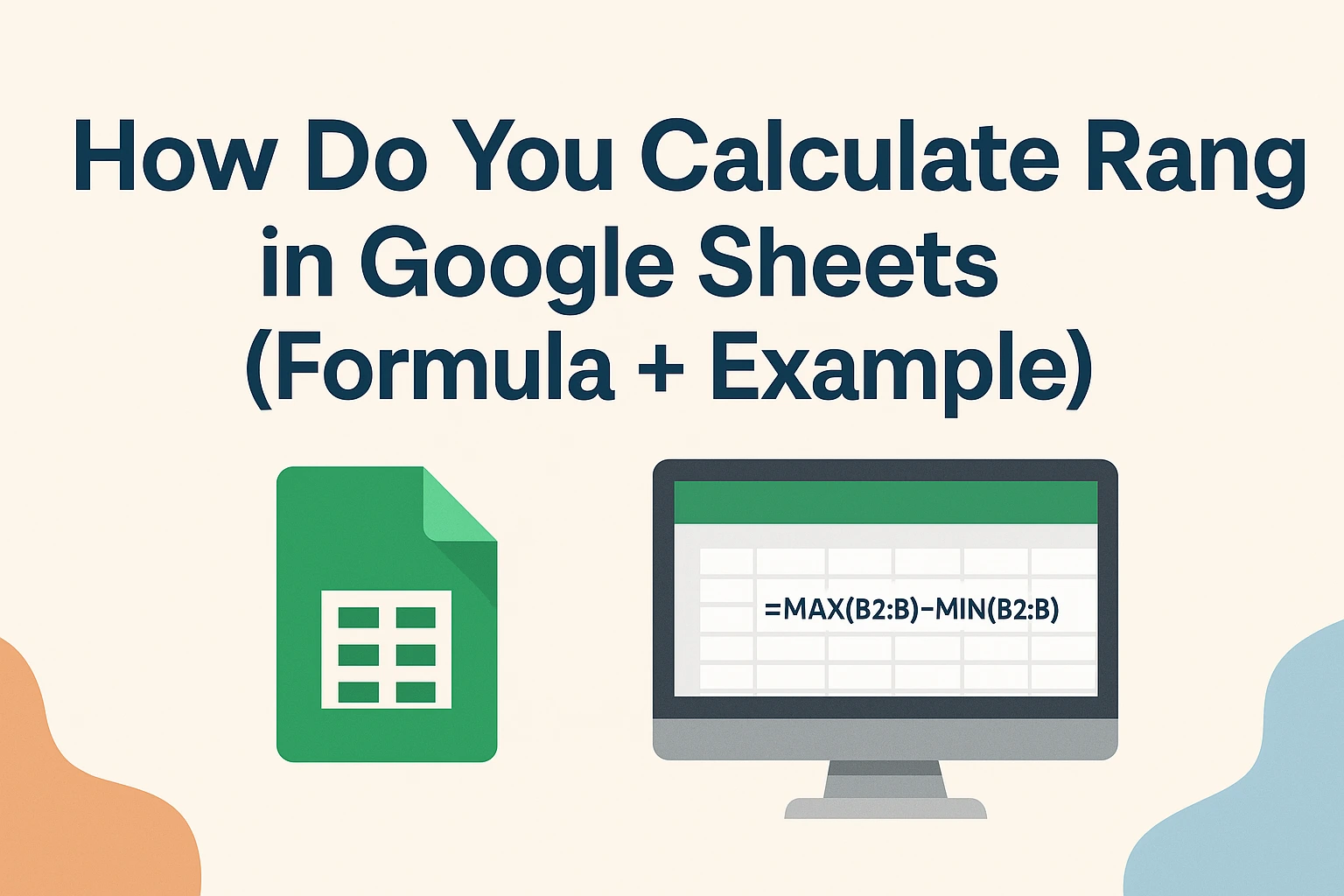If you’ve ever looked at a list of numbers and wondered, “Just how far apart are these values?” that’s where range comes in.
The range in statistics is one of those super straightforward concepts. You don’t need to be a math genius to understand it. Just take the biggest number in your dataset, subtract the smallest one, and bam you’ve got your range. Check exactly how do you calculate range?
Here’s the quick version:
Range = Maximum – Minimum
Let’s say you’re looking at these numbers: 12, 18, 27, and 35. The biggest number is 35. The smallest is 12. So, 35 minus 12 gives you 23. That’s your range your data stretches over 23 units.
Range is often the first thing people check when trying to understand how spread out their numbers are. It’s not super deep, but it’s fast and surprisingly useful. Whether you’re grading papers, reviewing sales figures, or analyzing sports scores — the range tells you something valuable in just a glance.
What Is Range, Really?
A Simple Explanation
Think of the range like the gap between two fences. One fence marks the lowest point, the other is the highest. Everything else falls in between.
In math speak, it’s:
mathematicaCopyEditRange = Max value – Min value
Nothing fancy. Just good ol’ subtraction.
Learn the official definition of range in statistics from the National Institute of Standards and Technology (NIST).
Don’t Mix It Up with Algebra’s “Range”
If you’ve taken algebra, you might remember hearing about the “range of a function.” That’s a totally different beast — it’s about all possible outputs of a function, not the spread of numbers in a list.
Here’s a quick side-by-side to keep things clear:
| Term | Context | What It Means | Example |
|---|---|---|---|
| Range (statistics) | Number sets | Difference between values | 98 – 65 = 33 |
| Range (math functions) | Algebra/calculus | Set of y-values | f(x) = x² → y ≥ 0 |
Why Should You Even Care About Range?
You might be wondering, “Why does this matter?” Good question.
Range helps you spot extremes in your data. It tells you how tight or spread out your numbers are. If you’re looking at student test scores, and the range is 10 points, that’s a pretty consistent group. If the range is 45 points? Someone aced it, and someone probably bombed.
A few real-world places where range comes in handy:
- Weather tracking (e.g. today’s high vs. low temp)
- Budgeting (expenses over the month)
- Sports stats (best vs. worst game)
- Retail (highest and lowest prices on an item)
It’s a fast way to figure out if something is stable… or all over the place.
How do you calculate range (By Hand)
Here’s a small example you can try right now.
Test Scores: 78, 83, 91, 67, 88
Step 1: Find the biggest number → 91
Step 2: Find the smallest number → 67
Step 3: Subtract → 91 – 67 = 24
Your range is 24 points. That’s the spread.
Visualizing It
Sometimes it helps to “see” the range on a number line:
sqlCopyEdit|----|----|----|----|----|----|----|----|----|----|
60 65 70 75 80 85 90 95 100
^ ^
Min (67) Max (91)
Just two points, and the rest falls between them.
Doing It in Excel, Google Sheets, or Python
Excel
- Put your numbers in cells (like A1 to A10)
- Use this formula in an empty cell: phpCopyEdit
=MAX(A1:A10) - MIN(A1:A10) - Hit Enter. Done.
This will give you the range instantly. You can drag the formula too, if you’re working with multiple datasets.
Google Sheets
Same exact steps as Excel. It even auto-updates when your data changes.
Want to go a little further? Add conditional formatting to color your highest and lowest values. It makes spotting them way easier.
Python (Using Pandas)
If you’re coding or handling a big dataset, this little snippet does the trick:
pythonCopyEditimport pandas as pd
data = pd.Series([12, 22, 19, 27, 15])
range_val = data.max() - data.min()
print("Range:", range_val)
Python handles it smoothly — great for automation or analysis.
But Wait — Range Has a Few Weak Spots
The biggest one? Outliers.
Let’s look at this dataset:
12, 14, 15, 16, 88
The range is 88 – 12 = 76. That sounds huge. But really, that “88” is way off from the others. It skews the range and makes it seem like the dataset is more spread out than it really is.
See how the range compares to IQR and standard deviation with this simple guide from Statology.
What Are Your Options?
Well, you can use other tools like:
| Measure | Outlier Sensitivity | When to Use |
|---|---|---|
| Range | Very Sensitive 🔴 | Quick snapshot |
| IQR | Less Sensitive 🟡 | Skewed or uneven data |
| Std. Dev. | Moderate 🟠 | Normal distributions or big sets |
Box plots are great for visualizing this. They show how most of your data sits in the middle, and whether you’ve got any sneaky outliers.
Special Cases (That Can Trip People Up)
Negative Numbers?
Still fair game. Let’s say your data is:
–10, –3, 0, 4, 6
Your max is 6. Min is –10.
So the range is 6 – (–10) = 16.
Just remember, subtracting a negative is like adding.
Dates and Times
In spreadsheets:
phpCopyEdit=MAX(A1:A10) - MIN(A1:A10)
Yep, same formula — just make sure the cells are formatted as “Date” or “Time.” You’ll get an answer in days, hours, etc.
Categorical Data?
It’s trickier. Range only works with numbers. But if your categories have implied rankings (like 1st, 2nd, 3rd), you can assign scores and calculate range that way.
Real-World Examples
📈 Finance: Daily Stock Movement
| Day | High | Low | Range |
|---|---|---|---|
| Monday | $140 | $132 | $8 |
| Tuesday | $138 | $134 | $4 |
🌡️ Weather Tracking
| Month | High Temp | Low Temp | Range |
|---|---|---|---|
| January | 47°F | 22°F | 25°F |
| July | 92°F | 74°F | 18°F |
🏀 Sports Performance
| Player | High Score | Low Score | Range |
|---|---|---|---|
| Player A | 32 pts | 14 pts | 18 |
Frequently Asked Questions
Can a range be negative?
Nope. It’s always zero or more, because you’re subtracting the smaller number from the larger one.
What happens if some cells are empty?
No biggie Excel and Google Sheets skip blanks automatically.
Should I use range or something else?
Use range for quick checks. Use IQR or standard deviation when you need depth or better handling of weird data.
How do I highlight the max and min in Sheets?
Use conditional formatting with formulas like:
=A1=MAX($A$1:$A$10)=A1=MIN($A$1:$A$10)
Conclusion & Key Takeaways
✅ The range is the simplest way to measure data spread
✅ It’s just the difference between the largest and smallest values
✅ You can calculate it manually or in tools like Excel, Sheets, and Python
✅ Watch out for outliers they can distort your results
✅ For deeper analysis, look at IQR or standard deviation
If you’re just dipping your toes into statistics, the range is a great starting point. It’s simple enough to grasp in seconds, but powerful enough to give you real insights especially when you’re working fast or dealing with messy data.
Whether you’re crunching numbers for work, school, or personal projects, the range helps you spot trends, compare data sets, and understand the “spread” at a glance. Try it out on your next dataset you might be surprised how much you can learn from just two values.






One Response
Nice post! 1754809865